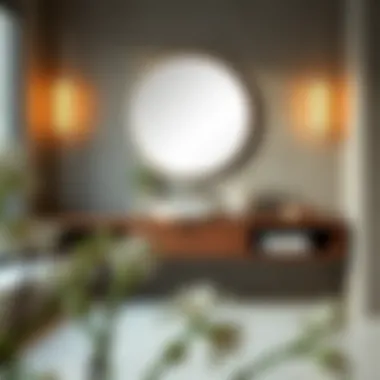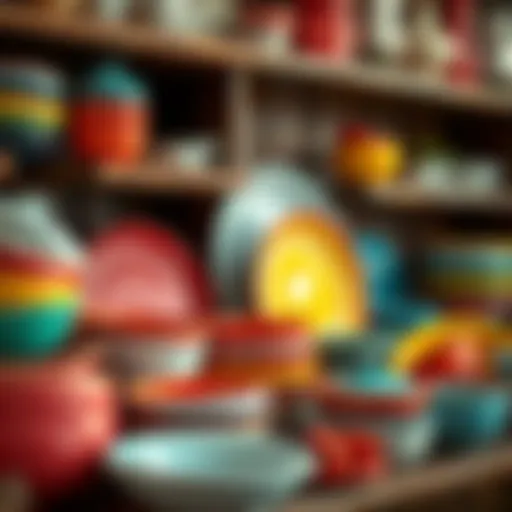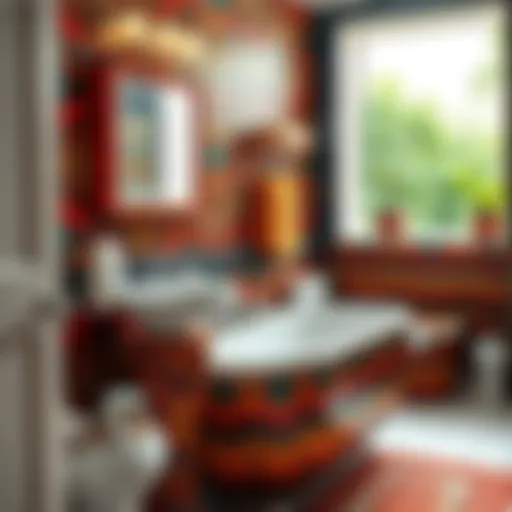Exploring the Floating Vanity Table: Design and Trends


Intro
The floating vanity table has really found its place in today’s homes. It's not just a piece of furniture but rather a statement of style and practicality. With more people seeking to optimize their living spaces, these vanity tables have become a favorite for homeowners. They give a sense of airiness. Imagine a slim table hanging gracefully on the wall, providing ample space underneath. It’s not just about looks; it's also about how much easier they can make your day-to-day life.
A floating vanity table can add elegance to a bathroom without the bulk of traditional furniture. They're not just for show—these tables often feature clever storage options, blending function with design. As we delve into the myriad facets of floating vanity tables, we’ll explore how to pick the right one that mirrors your personality, fits your space, and serves your needs best.
Furniture Styles and Trends
Modern vs. Traditional: Understanding the Aesthetics
Floating vanity tables come in a variety of styles. The modern designs typically feature clean lines, minimalism, and often boast sleek materials such as glass or metal. You might observe duos of whites and grays, reflecting a contemporary palette. On the other hand, traditional styles often infuse rich woods and intricate details. They might echo a bygone era, using ornate elements that can make a bathroom feel warm and inviting.
When looking at trends, it's crucial to ask:
- What aesthetic speaks to you?
- How does it harmonize with the existing style of your home?
Understanding the balance between modern and traditional can help determine what works best for your space.
Color and Material Trends: What's In and What's Out
A shift towards vibrant colors is noticeable among those wanting to make a statement. Bold blues, deep greens, and even rich burgundies are making waves on the market. Meanwhile, neutrals still hold their ground for those who prefer something subtle.
Material choices are also evolving. While wood remains a classic, you'll see a growing use of sustainable materials. Bamboo or reclaimed wood not only looks good but is environmentally friendly as well. Metal finishes—brass and matte black—are trending for fixtures to give that “wow” factor.
A floating vanity table isn't just a functional piece; it’s an artful addition to your space that showcases personality and style.
Furniture Care and Maintenance
Tips for Prolonging the Life of Your Furniture
Maintaining your floating vanity table is easier than you might think. Follow these tips to keep it looking fresh:
- Regular Cleaning: Use mild soap and a soft cloth to avoid scratching the surface. Avoid abrasive materials as they can damage the finish.
- Conditioning: For wooden surfaces, consider applying a wood conditioner every few months to prevent drying or cracking.
- Avoid Excessive Weight: While they’re strong, avoid piling on weight that the design isn't intended for. This helps prevent damage and maintain aesthetic appeal.
DIY Repair Hacks for Common Furniture Issues
If your vanity table has seen better days, don’t fret. A few DIY repairs can do wonders:
- Scratch Repair: Use a crayon that matches the color of the wood to fill in scratches, then buff lightly with a soft cloth.
- Tightening Hardware: Make sure screws are tightened over time. They can become loose and affect stability.
- Touch-Up Paint: For painted surfaces, keeping a touch-up paint handy can save you from elaborate repair jobs.
Understanding how to care for your floating vanity table not only enhances its lifespan but also preserves its beauty.
Understanding Floating Vanity Tables
Understanding floating vanity tables is crucial for anyone looking to enhance their living spaces or optimize their home design. These uniquely designed pieces combine style with functionality and are rapidly becoming a preferred choice for modern homeowners. While the aesthetic appeal of floating vanities is evident, their significance extends far beyond mere looks. They redefine organization, maximize available space, and add a contemporary flair to various rooms within a home.
Definition and Concept
A floating vanity table is a type of furniture that is mounted to the wall without support from the floor. This suspension creates an illusion of space and can make rooms appear larger and more open. Typically found in bathrooms, bedrooms, and home offices, these tables are often equipped with drawers or shelves for storage while providing a sleek surface for various tasks such as grooming or working. The concept revolves around minimalism, emphasizing clean lines and straightforward forms, which appeal to a broad audience, from design aficionados to practical homeowners looking for functional solutions.
In essence, floating vanity tables offer a merge of artistry and efficiency. They reflect a modern lifestyle that values both form and function. By choosing a floating vanity, individuals can not only utilize the floor space more effectively but also create a visually striking focal point that enhances the overall decor of the room.
Historical Context
The inception of floating furniture can be traced back to various design movements that emphasized openness and space, notably in the early 20th century with the influence of Bauhaus and modernism. Initially, the notion of furniture 'floating' was conceived from a desire to bring more light into interior spaces, influenced by the post-World War II era’s shift toward minimalism. Houses became smaller, and with that change, the need for multi-functional pieces increased.
The floating vanity as we know it today began to gain traction in the late 20th century alongside advancements in modular furniture design. This innovation allowed for more versatile furniture solutions, which could adapt to the dynamic needs of living environments. As such, floating vanity tables evolved from simple, utilitarian objects to versatile statement pieces that reflect personal style. Through time, they have become synonymous with sophistication and design innovation, illustrating the historic journey of furniture that is not only practical but also artful.
"A floating vanity table is more than just furniture; it embodies a philosophy of space-saving and elegance that has evolved through centuries."
Through exploring the definition and historical context of floating vanity tables, we grasp a clearer understanding of their significance in modern interior design. This foundational knowledge sets the stage for an in-depth exploration of their advantages, design variations, and trends that will follow.
Advantages of Floating Vanity Tables
Floating vanity tables are quickly becoming favorites in modern interior design. Their ability to combine functionality with a flair for aesthetics makes them a sought-after choice for many homeowners. This section outlines the key advantages of floating vanity tables in your living spaces.
Space Efficiency
When it comes to maximizing space, floating vanity tables take the cake. These tables typically mount directly on the wall, freeing up floor space which can make even the coziest corners feel more open. Imagine a small bathroom where every square inch counts. A cleverly placed floating vanity can give the illusion of added space, which can be a game changer for cramped quarters. It’s like optical illusion in furniture form, drawing the eye upwards and making the room feel more expansive.
Additionally, the area beneath the vanity can be utilized for storage or decorative plants, enhancing both functionality and aesthetics. Say goodbye to bulky, floor-standing furniture that hogs all the attention. ##
Aesthetic Appeal
Floating vanity tables aren’t just practical; they’re also visually striking. The sleek, minimalist designs that accompany these vanities pair beautifully with various decor styles. Imagine a corkscrew-shaped mirror hanging over a chic, white-washed floating vanity. The clean lines and lack of bulky hardware can elevate a room's overall design.
The versatility is another feather in their cap. Whether your taste leans toward contemporary chic or vintage rustic, there’s a floating vanity table that could fit right in. The option to choose different materials, finishes, and designs means these tables can serve as a standout feature or blend seamlessly with your existing decor.
"Floating vanities exemplify modern craftsmanship while emphasizing elegance and simplicity."
Customization Options
Another notable benefit is the level of customization available with floating vanity tables. Unlike traditional vanities that come in set sizes and designs, many floating options can be tailored to individual needs. Homeowners can select wood types, colors, and unique hardware that resonate with their personal style.
Some prefer the warmth of natural wood, while others might lean towards the sleek contemporary vibe of glass or metal finishes. This variety allows for a stronger connection between the vanity and the overall theme of the room.


Here are some ways you can customize your floating vanity:
- Size: Customize the dimensions to fit the available wall space.
- Color: Choose paints or stains that align with your room's palette.
- Storage solutions: Consider built-in compartments or shelving depending on your needs.
With floating vanities, you’re not just buying a piece of furniture; you’re investing in a centerpiece that reflects your unique taste and enhances your home.
Design Variations
In considering the floating vanity table, one must pay careful attention to the various design variations available. These variations not only serve aesthetic purposes but also address practical needs within different spaces. Selecting the right design variation can significantly enhance the overall vibe of a room while ensuring functionality. Each material, style option, and color scheme contributes uniquely to creating a floating vanity that aligns with personal tastes and lifestyle demands.
Material Choices
Wood
Wood is a timeless choice for many interior applications, including floating vanity tables. Its warmth and natural beauty bring a sense of comfort and earthy elegance to any space. One of the key characteristics of wood is its ability to complement numerous design styles, from cozy rustic settings to sleek contemporary designs.
A unique feature of wood is its vast range of grains and finishes. This allows homeowners to select anything from an oak warmth to a robust walnut, making wood a highly versatile option. However, it’s essential to consider the implications of moisture exposure, especially in environments like bathrooms, where humidity can warp and damage wood.
Metal
Metal has become increasingly popular, particularly for its durability and modern appeal. Whether it's stainless steel, brass, or wrought iron, metal brings an edgy, industrial flair to floating vanity designs. Its key characteristic lies in its strength, making it an excellent choice for heavier-use areas, like a busy family bathroom.
One outstanding advantage of metal is its low maintenance. Unlike wood, it doesn’t warp or swell with moisture. On the flip side, metal can feel cold to the touch and may lack the warmth that wood offers. Balancing metal accents with softer elements can create a well-rounded design.
Glass
Glass is another compelling material, often utilized for its light-reflecting qualities and modern aesthetic. Floating vanities featuring glass surfaces can make even the smallest spaces feel more open and airy. The key characteristic of glass is its transparency, allowing it to blend seamlessly into various designs without overpowering the visuals.
However, one must be cautious of glass fragility. While tempered glass is sturdy, it can still be prone to scratching and requires regular cleaning to maintain clarity. When opting for a glass floating vanity, one should weigh the need for a chic look against the practicalities of maintaining its appearance.
Style Options
Contemporary
Contemporary style focuses on clean lines, minimalism, and practicality, making it a fit for modern floating vanities. This style contributes to an uncluttered visual aesthetic, prioritizing form and function equally. Its key characteristic is simplicity—furniture often features sleek designs with few embellishments.
The unique feature of contemporary floating vanities lies in their functionality. They often come equipped with built-in storage that maximizes utility without sacrificing style. However, it's crucial to balance the minimalistic approach so as not to create an overly sterile feeling in the space.
Rustic
Rustic style brings a sense of warmth and coziness to any room. Its charm comes from materials that look reclaimed or aged, often focusing on natural beauty. A key characteristic of rustic floating vanities is their textural depth, often showcasing knots, grains, and imperfections that provide character.
A unique advantage is the way rustic designs can make a bathroom feel inviting and homey. Yet, these vanities may not fit in with more modern designs, making careful consideration of overall home aesthetics essential.
Industrial
The industrial style combines raw materials and a sense of urban sophistication. Floating vanities designed with this in mind often showcase elements such as exposed metal frames paired with reclaimed wood surfaces. A key characteristic is an unapologetic embrace of the unfinished look, presenting a bold contrast to softer elements in the space.
Advantages include a very trendy aesthetic that appeals to many modern homeowners, but translation into a cozy home environment can be tricky. Successful industrial designs need to be balanced with warmer features to avoid making a space feel too cold or uninviting.
Color Schemes
Neutral Tones
Neutral tones encompass shades like beige, gray, and taupe, providing a sophisticated backdrop for any floating vanity. Their key characteristic is versatility; these colors can blend seamlessly into various design themes, making them a favorite among those looking for a timeless design.
Unique features of neutral tones include their ability to make small spaces feel larger and airy. However, some may view them as uninspired if not paired thoughtfully with other design elements. A common approach is to accessorize with colorful items to liven up the neutral base without overwhelming it.
Bold Accents
Bold accent colors can offer a striking contrast to a floating vanity, instantly transforming it into a focal point. Colors like teal, burgundy, or vibrant yellow can inject personality and vibrancy into a design. The key characteristic is their ability to capture attention; a bold floating vanity can define a room's character.
While bold accents can energize a space, an overemphasis on vivid tones might make an area feel chaotic. It's wise to add bold elements thoughtfully and ensure they harmonize with the rest of the design.
Monochromatic
Monochromatic schemes rely on variations of a single color, creating a cohesive and sophisticated look. This approach offers a calming effect, making it suitable for spaces aimed at relaxation, like bathrooms. A key characteristic of monochromatic designs is the depth created through different shades and textures.
The unique advantage lies in how easily they blend various elements, offering an elegant and unified feel. However, monochromatic schemes can risk being monotonous if not executed with careful consideration of texture and form.
In summary, understanding the design variations for floating vanity tables is paramount to finding the perfect fit for one's space. Selecting the right material, style, and color scheme not only meets functional needs but also enhances the overall aesthetics of the home.
Installation Considerations
When it comes to floating vanity tables, proper installation is fundamental, ensuring that both aesthetics and functionality are met. This section addresses various aspects, including wall support structures, height considerations, and whether to take a DIY approach or hire a professional. Understanding these elements not only enhances the reliability of the installation but also ensures that the piece resonates well with the overall interior design of your home.
Wall Support Structures
The foundation of any floating vanity table relies on robust wall support structures. Traditional cabinets often rely on the floor for support, but floating designs demand a more specialized approach. It's essential to identify the type of wall you’re working with before proceeding. For example, drywall alone cannot sustain heavy loads without reinforcement. If your home has wooden studs, it is crucial to anchor the mounting brackets directly into them for adequate support, ensuring a sturdy installation.
Some homeowners might consider using hollow wall anchors, but these should be used with caution. They can potentially fail under weight if not properly installed. Therefore, evaluating the wall's structural integrity is a vital first step. Here are key considerations:
- Material: Solid walls, like concrete or brick, may require particular tools for mounting.
- Load-Bearing Capacity: Assess how much weight the vanity will carry. Typically, a wall can support a floating vanity if formatted correctly to distribute weight safely.
- Placement: Ideally, the vanity should be hung where it can easily align with plumbing if it is intended for a bathroom setting.
Height and Ergonomics


Another critical aspect of installation revolves around height and ergonomics. A floating vanity table should cater to the users' comfort, which varies from person to person. A general rule of thumb is to mount the vanity’s top surface between 28 to 36 inches from the floor, depending on its intended use.
When considering height:
- User Height: Tailor the height according to who will frequently use the table. A family with children may benefit from a lower installation, while adults might prefer a higher elevation.
- Functionality: Will it be used for daily grooming activities or as a workspace? Ensure the height accommodates both standing and seated positions, particularly if used with a stool or chair.
Installing the floating vanity at an improper height could lead to discomfort, which defeats its purpose. Therefore, measuring and double-checking is a must before securing the installation.
Professional vs. DIY Installation
Choosing between a professional installation and a DIY approach can be daunting. While opting to do it yourself might save you funds, it also comes with risks if you're not familiar with home installation. Professional installers bring experience and tools, reducing the chance of errors. Conversely, doing it yourself can be quite gratifying, offering a sense of ownership over the finished product.
Here are some pros and cons of each approach:
DIY Installation
- Pros:
- Cons:
- Cost-effective, saving money on labor.
- Personal investment in a project is often rewarding.
- Time-consuming and may require additional purchases (tools, materials).
- Risks of improper installation that could damage the vanity or wall.
Professional Installation
- Pros:
- Cons:
- Expert knowledge ensures the vanity is securely installed.
- Saves time as they can complete the work efficiently.
- Added cost for labor.
- Limited control over installation methods unless discussed beforehand.
In the end, the right choice depends on your budget, skills, and comfort level with home improvement tasks.
Maintenance of Floating Vanity Tables
The upkeep of floating vanity tables is not just a matter of aesthetic appeal but also about prolonging their lifespan and functionality. These unique pieces add a modern touch to a space, yet they also require certain attentiveness to ensure they remain in excellent condition. In this section, we examine the specific elements crucial to the maintenance of these tables, going into the benefits they bring to your home, along with essential considerations for caring for them.
Cleaning Techniques
Keeping a floating vanity table spotless is paramount. Regular cleaning not only enhances its look but also prevents the buildup of grime that can lead to deterioration.
- Use Mild Cleaners: Opt for gentle, non-abrasive cleaners that are specifically designed for the material of your vanity. For instance, wooden surfaces benefit from cleaning with a damp cloth followed by a dry one, avoiding excess water that could warp the wood.
- Dust Regularly: It is a good practice to dust the surface at least once a week to prevent particles from scratching the finish over time.
- Stain Treatment: For stains, a quick wipe with a mix of water and vinegar can often do wonders. However, ensure to test in a small area first to avoid damaging the finish.
- Avoid Harsh Chemicals: Steer clear of bleach and similar strong chemicals that can dull or damage the surface. This is especially true for materials like glass or painted surfaces.
By establishing a regular cleaning schedule, you not only maintain the vanity’s appearance but also enhance its durability, keeping it welcoming for years to come.
Damage Prevention
To extend the life of your floating vanity table, prevention is key. Damage can stem from several sources, and being proactive about it can save both time and money.
- Use Coasters: Always use coasters under products like perfume or lotions. This simple step reduces the risk of rings or scratches on the surface.
- Temperature Sensitivity: Be mindful of temperature changes, particularly in bathroom environments. Hot styling tools can leave marks or discoloration, so it's wise to have a dedicated heat-resistant mat.
- Secure Your Items: A cluttered surface can lead to accidents. Use organizers to keep items orderly and secure—this reduces the chance of knocking something over or causing damage during daily use.
- Regular Inspections: Routinely check for any loose screws or fittings in the wall mounts. Addressing these small issues before they escalate can prevent potential hazards or collapses.
By implementing these maintenance practices, you not only protect your floating vanity table but also embrace its potential as a centerpiece in your home.
Proper care and attention to maintenance ensure that floating vanity tables remain an attractive feature while serving their functional purposes effectively. For homeowners and designers alike, understanding how to properly maintain these fixtures is as crucial as their initial placement and design.
Floating Vanity Tables in Different Spaces
Floating vanity tables have carved a niche in modern home design, transcending their traditional utility to become versatile pieces that fit seamlessly into various environments. Recognizing the broad range of applications for these elegant structures is essential for homeowners and designers alike. Floating vanities don’t just occupy space; they redefine it, breathe life into interiors, and blur the lines between form and function. Here, we will explore how these clever designs enhance different rooms, catering to the unique needs and lifestyles of their inhabitants.
In the Bathroom
When it comes to bathrooms, floating vanity tables shine not only in aesthetics but practically. They can elevate the overall look of the space, making it feel both spacious and organized. One of the noteworthy elements of floating vanities is their ability to create an illusion of more floor area. Since they hang above the ground, you gain more visible space, making smaller bathrooms appear less cramped. It’s similar to the trick of using mirrors in a tiny room; it plays with visual perception.
- Organizational Potential: With drawers or open shelves beneath, these vanities offer a way to store essential toiletries and makeup, keeping counters uncluttered and surfaces airy.
- Cleaning Made Easy: Traditional vanities often accumulate dust and grime underneath; however, the floating design simplifies cleaning, as there are no places for dirt to hide.
As a result, the floating vanity can transform a mundane bathroom into a sanctuary. Choosing materials like moisture-resistant wood or glass can enhance durability while being sleek at the same time. For example, a walnut floating vanity complements modern decor with warmth while standing up to humidity effectively.
In the Bedroom
In bedrooms, floating vanity tables take on a more personalized role. They serve not just as practical furniture but as a reflection of one's style and identity. A floating vanity table can provide a chic area for morning routines—think of it as a dedicated space just for you, away from the regular bustle of the household.
- Personal Touch: Adding decorative elements like mirrors or elegant lighting underscores one's personality. Consider a minimalist design with a simple white lacquer finish to keep things light and airy or a deep black wood for a touch of luxury.
- Functional Design: Many homeowners find these vanities ideal for storing accessories, cosmetics, or even personal journals. This can help create a sense of calm and order, especially on busy mornings when every minute counts.
Integrating a floating vanity in the bedroom can also present color coordination opportunities. For instance, if the room features a pastel color scheme, a softly colored floating table can harmonize beautifully while providing contrast against muted tones.
In the Home Office
The shift towards remote working has made the home office a vital part of daily life. Here, floating vanity tables can transition smoothly into workspace desks, merging functionality with elegance. A well-designed floating table can serve as a dual-purpose area where you can both work and unwind.
- Space Savvy Design: Compact and stylish, a floating vanity can be a desk during the day and a personal beauty station at night. This is highly advantageous for smaller homes, where maximizing the use of space is crucial.
- Ergonomic Layout: With the right height considerations, a floating table can establish an ideal workstation that promotes good posture—essential when your work requires hours of screen time.
Choosing a configuration that allows for an organized setup of office supplies alongside beauty essentials can keep the workspace both efficient and visually pleasing. Picture a steel frame with a wooden top: durable and perfectly adaptative to any home office style.
"The right floating vanity can enhance functionality, streamline your routine, and fit beautifully within the design ethos of your home."
Through strategic placement and thoughtful design, floating vanity tables in various spaces not only elevate the visual appeal but also contribute to a more organized, modern living experience.


Trends Influencing Floating Vanity Table Design
As the concept of home design continues to evolve, floating vanity tables have established themselves as a key player, making their way into various spaces, from bathrooms to home offices. This section highlights the trends shaping their design—essential for homeowners, designers, and retailers alike. Understanding these trends allows for not only aesthetic enhancements but also functional improvements, ensuring the floating vanity remains a staple in modern interiors.
Sustainable Materials
In recent years, the shift towards sustainability has permeated every corner of interior design. Floating vanity tables constructed from recycled or reclaimed materials are gaining traction. This not only reduces the environmental impact but also adds unique character to the pieces. For instance, using reclaimed wood offers a rustic charm—every knot and mark tells a story, making each piece one-of-a-kind. Moreover, sustainable materials are often sturdier, ensuring durability while supporting eco-friendly practices.
Homeowners can look into sources such as local artisans or specialized retailers that prioritize sustainable options. Additionally, investing in products labeled with certifications like FSC (Forest Stewardship Council) can provide peace of mind about the materials used in their floating vanities.
Smart Technology Integration
The rise of smart homes has led to the integration of technology into furniture design, and floating vanity tables are no exception. Imagine a vanity equipped with built-in LED lights that adjust brightness based on the time of day, helping to achieve the perfect makeup application. Some models even include smart mirrors with touchless controls, allowing users to check the weather, play music, or browse through their daily schedule—all while preparing for the day ahead.
Furthermore, the use of charging ports and wireless charging pads within the vanity itself caters to the tech-savvy audience. This ensures that gadgets are within reach and enhance the user experience. As technology advances, expect to see more sophisticated automation features being implemented, further blurring the lines between furniture and smart home ecosystem.
Minimalist Approaches
In an age where clutter is the enemy, the minimalist approach to design has gained immense popularity. Floating vanity tables are increasingly being designed with clean lines and a pared-back aesthetic. This trend prioritizes functionality and simplicity over ornate designs, allowing the vanity to seamlessly integrate into the space without drawing too much attention.
A minimalist floating vanity can provide an open, airy feel—great for smaller spaces where maximized visual real estate matters. Choosing neutral color palettes—whites, grays, and soft earth tones—further enhances this effect.
For those looking to adopt this trend, opting for a floating vanity with integrated storage can be a game-changer. Concealing beauty products and daily essentials behind closed drawers or within embedded compartments reduces visual clutter and promotes a serene environment.
A floating vanity that embodies minimalist qualities not only elevates the room’s aesthetics but also cultivates a sense of calm and clarity in daily routines.
Budgeting for a Floating Vanity Table
Understanding the financial commitment involved in purchasing a floating vanity table is crucial for any homeowner or designer. With the rise of modern interior design trends, floating vanity tables have captured the attention of many, but the question of cost often looms large. Proper budgeting can make all the difference between a seamless installation and a project rife with unexpected expenses. This section delves into the cost breakdown and the concept of value versus cost, helping you to foresee the financial landscape ahead.
Cost Breakdown
When you set out to budget for a floating vanity table, it’s important to break down the costs involved. Generally, the price can vary based on several factors:
- Materials: The type of material—be it wood, metal, or glass—will greatly influence the price. Solid wood tends to be on the pricier side, while engineered wood or MDF panels may offer a more economical option.
- Size and Design: Larger vanities or those with intricate designs usually demand a higher price tag. Custom designs can even drive costs up significantly.
- Hardware: Don’t overlook fittings and accessories, like drawer handles and wall anchors. These components can add additional expense.
- Installation Fees: If you’re not handy with tools, professional installation could contribute to the overall cost. It’s wise to get quotes from a few contractors to ensure you’re not left with a lemon of a deal.
- Maintenance: Consider the long-term costs associated with maintenance. Some materials may require more upkeep than others. For example, some countertops may need resealing or special cleaning agents.
Calculating these costs ahead of time can help you prioritize where you want to invest more resources and what can be skimped on without sacrificing quality.
Value vs. Cost
The balance between value and cost cannot be emphasized enough when considering a floating vanity table. It’s easy to be tempted by a lower price, but this could lead to compromises in quality or longevity. Here are a few points to ponder:
- Investing in Longevity: Often, furniture that costs more isn’t just an expenditure; it’s an investment. High-quality materials can be more durable, potentially saving you money in replacement costs down the line.
- Functionality over Aesthetics: While it’s all well and good to buy a table that looks fabulous, don’t forget to consider its functionality. A cheap vanity that doesn’t meet your needs can be more frustrating than its worth.
- Resale Value: Should you ever decide to sell your home, well-made furniture typically adds value. Buyers are often willing to pay more for homes featuring high-quality fixtures and finishes.
Ultimately, it’s the overall value—the combination of cost, quality, and functionality—that should guide your decision. The extra research into finding the right balance can save you not just dollars, but also headaches down the line.
"Well-planned budgeting leads to better buying decisions, making it possible to enjoy the best of both worlds: stylish design and function."
Confronting Common Myths
Floating vanity tables, while an increasingly popular choice in modern home design, are often surrounded by misconceptions that can steer potential buyers away. It’s important to address these myths to provide clarity on their durability, functionality, and overall value in home décor. Understanding the truth behind these misconceptions not only aids homeowners in making informed decisions but also opens the door for broader acceptance of innovative designs in interior spaces.
Durability Concerns
One prevailing myth about floating vanity tables is that they lack durability compared to traditional, freestanding models. Many people assume that a wall-mounted design might be less sturdy or may not hold heavy items. However, this notion couldn’t be further from the truth. With proper installation, which involves securing the table to wall studs or, for heavier models, using reinforcement brackets, floating vanities can be as robust, if not more so, than their counterparts.
Materials play a crucial role in this equation as well. High-quality wood, metal, or engineered materials used in crafting floating vanities contribute not just to aesthetic appeal but also significantly enhance their durability. Regular maintenance, such as minor touch-ups and proper cleaning, ensures they can withstand daily use without losing their charm.
"A floating vanity, when installed correctly, can hold the weight of all your essentials while adding an airy quality to your space."
Furthermore, the visual lightness of a floating table often leads to the misconception that it is fragile. In reality, this design choice provides a modern flair, creating an illusion of more space, without compromising stability. When choosing a vanity, it's wise to consider products that come with warranties or are from reputable manufacturers to further ease concerns of longevity and performance.
Installation Difficulty
Another common belief is that installing a floating vanity table is a Herculean task that only seasoned professionals can tackle. This could not be more misleading. While it's true that proper installation is paramount in ensuring the safety and stability of the vanity, many homeowners find the process quite manageable with the right tools and guidance.
The key to successful installation lies in understanding the wall dynamics and the necessary support systems. For instance, locating wall studs is essential for providing adequate support. There are multiple resources available online, including video tutorials and step-by-step guides, that can walk even the most novice DIYer through the process.
Many floating vanities come with comprehensive instructions or even offer pre-drilled mounting holes, making the installation smoother. In cases where uncertainties arise, consulting with professionals is always an option. Nonetheless, many find that installing a floating vanity table can be both a fulfilling and manageable task, adding a touch of luxury without needing a complete renovation.
In summary, confronting these myths not only fosters a more informed understanding of floating vanity tables but also encourages homeowners to embrace this stylish and practical solution in their spaces.
The Future of Floating Vanity Tables
The trajectory of floating vanity tables is closely intertwined with contemporary lifestyle choices and interior design trends. As more homeowners prioritize efficiency and aesthetics, understanding the future of these elegant installations becomes crucial. Floating vanity tables stand at the intersection of functionality and style, appealing to a wide array of personal preferences and spatial requirements.
In the ever-evolving landscape of home decor, floating vanities are more than just a fad; they're a reflection of how we are reshaping our living spaces to be more versatile and efficient. This section will delve into emerging trends and predictions, offering insights that will benefit homeowners, designers, retailers and DIY enthusiasts alike.
Emerging Trends
The appeal of floating vanity tables continues to gain momentum due to their alignment with several current trends. Let’s examine some of the more distinct movements shaping their future:
- Sustainability: Eco-friendly designs are becoming a priority for many, with manufacturers focusing on sustainable materials. Bamboo and reclaimed wood are favored choices, providing durability without compromising environmental considerations.
- Customization: Consumers are seeking bespoke solutions. This has led to a rise in customizable floating vanity options, allowing buyers to select their preferred finishes, dimensions, and accessories. This personalization reflects individual tastes much more than pre-made stock items.
- Technology Integration: Smart homes are on the upswing. Floating vanities equipped with touchless faucets, integrated lighting, and digital scales are being demanded more frequently. This trend allows users to blend functionality with modern tech comforts.
- Multi-Functionality: There's a shift towards pieces that serve multiple purposes. Floating vanities are evolving into compact desks or grooming stations that can easily transition between uses, catering to smaller living spaces.
"The future of floating vanity tables is not just about providing a surface; it's about enhancing the overall user experience in the home."
Imagining these continuing innovations isn’t just a luxury; it reflects a shifted mindset towards practical, stylish living.
Predictions
Looking ahead, the future of floating vanity tables can be painted in a few vivid strokes:
- Enhanced Ergonomics: As awareness grows around comfort and health in design, floating vanities will likely be engineered with better height and accessibility standards, ensuring ease of use for all.
- Minimalist Designs Will Prevail: Simplicity will reign supreme. The trend leans towards sleek forms and subtle hardware, allowing beauty to be found in function.
- Increased DIY Options: As DIY culture continues to rise, more tutorials and kits for building floating vanities could emerge, empowering individuals to design pieces that complement their particular style.
- Growing Online Marketplaces: E-commerce has altered shopping habits. Future floating vanities may be specifically designed for the online shopper, with assembly becoming easier for shipment.
- Integration of Wellness Features: Expect vanity tables to begin incorporating elements aimed at overall well-being, from lighting that promotes healthier skin routines to surface materials that repel bacteria.















